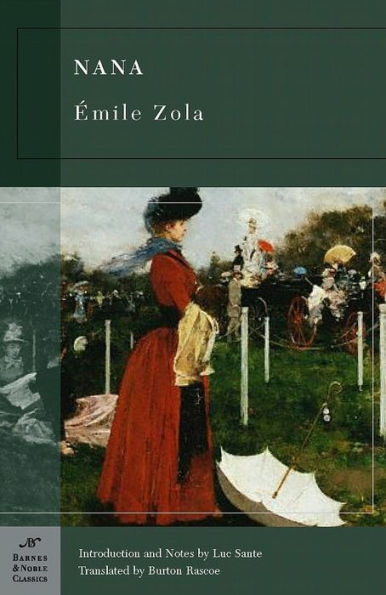Nana, by Emile Zola, is part of the Barnes & Noble Classics series, which offers quality editions at affordable prices to the student and the general reader, including new scholarship, thoughtful design, and pages of carefully crafted extras. Here are some of the remarkable features of Barnes & Noble Classics:
- New introductions commissioned from today's top writers and scholars
- Biographies of the authors
- Chronologies of contemporary historical, biographical, and cultural events
- Footnotes and endnotes
- Selective discussions of imitations, parodies, poems, books, plays, paintings, operas, statuary, and films inspired by the work
- Comments by other famous authors
- Study questions to challenge the reader's viewpoints and expectations
- Bibliographies for further reading
- Indices & Glossaries, when appropriate
One of the founders of literary naturalism, Émile Zola thought of his novels as a form of scientific research into the effects of heredity and environment. He created characters, gave them richly detailed histories, and placed them in carefully observed, precisely described environments, and his readers watch as they wriggle and thrash toward their inevitable destinies.
In Nana, the characters are a prostitute, who rises from the streets to become what Zola calls a “high-class cocotte,” and the men—and women—whom she loves, betrays, and destroys. Among the novel’s many ironies is the mutual envy felt by Nana and those around her. She yearns for their material possessions, while they admire her apparent independence and sexual self-confidence. And despite the chaos Nana causes, Zola imagines her as being essentially “good-natured,” a stupid, vain but beautiful creature who can’t help drawing people into her web.
Not surprisingly, Nana’s portrait of a decadent world in which a prostitute amasses great wealth and power provoked protests from “polite society,” and it became one of Zola’s most controversial works. Today it is regarded as his masterpiece.
Luc Sante is the author of Low Life, Evidence, and The Factory of Facts and coeditor, with Melissa Holbrook Pierson, of O.K. You Mugs: Writers on Movie Actors.
Nana, by Emile Zola, is part of the Barnes & Noble Classics series, which offers quality editions at affordable prices to the student and the general reader, including new scholarship, thoughtful design, and pages of carefully crafted extras. Here are some of the remarkable features of Barnes & Noble Classics:
- New introductions commissioned from today's top writers and scholars
- Biographies of the authors
- Chronologies of contemporary historical, biographical, and cultural events
- Footnotes and endnotes
- Selective discussions of imitations, parodies, poems, books, plays, paintings, operas, statuary, and films inspired by the work
- Comments by other famous authors
- Study questions to challenge the reader's viewpoints and expectations
- Bibliographies for further reading
- Indices & Glossaries, when appropriate
One of the founders of literary naturalism, Émile Zola thought of his novels as a form of scientific research into the effects of heredity and environment. He created characters, gave them richly detailed histories, and placed them in carefully observed, precisely described environments, and his readers watch as they wriggle and thrash toward their inevitable destinies.
In Nana, the characters are a prostitute, who rises from the streets to become what Zola calls a “high-class cocotte,” and the men—and women—whom she loves, betrays, and destroys. Among the novel’s many ironies is the mutual envy felt by Nana and those around her. She yearns for their material possessions, while they admire her apparent independence and sexual self-confidence. And despite the chaos Nana causes, Zola imagines her as being essentially “good-natured,” a stupid, vain but beautiful creature who can’t help drawing people into her web.
Not surprisingly, Nana’s portrait of a decadent world in which a prostitute amasses great wealth and power provoked protests from “polite society,” and it became one of Zola’s most controversial works. Today it is regarded as his masterpiece.
Luc Sante is the author of Low Life, Evidence, and The Factory of Facts and coeditor, with Melissa Holbrook Pierson, of O.K. You Mugs: Writers on Movie Actors.

Nana (Barnes & Noble Classics Series)
496
Nana (Barnes & Noble Classics Series)
496eBook
Related collections and offers

Product Details
| ISBN-13: | 9781411432741 |
|---|---|
| Publisher: | Barnes & Noble |
| Publication date: | 06/01/2009 |
| Series: | Barnes & Noble Classics Series |
| Sold by: | Barnes & Noble |
| Format: | eBook |
| Pages: | 496 |
| Sales rank: | 157,948 |
| File size: | 2 MB |
| Age Range: | 3 Months to 18 Years |
About the Author
Customer Reviews
Explore More Items
The Romantic Adventures of a Milkmaid is a classic romance novel by Thomas Hardy and a romantic and comedic tour de force.Thomas Hardy OM (2 June 1840 – 11 January 1928) was an English novelist
